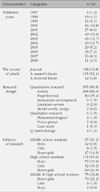Abstract
Purpose
The purpose of this study was to analyze the contents and trends of smoking and smoking cessation of adolescents in Korea.
Methods
The subjects were 315 researches from 1997 to 2008 in Korea. They were examined in terms of subjects, research design, key words, types of intervention, times of intervention, and dependent variables for experimental research, and in terms of subjects, concepts, research questions and research methods for qualitative research.
Results
Of the studies 52.4% were master's theses, and 22.9% of the subjects were male high school students. The most common research design was descriptive design. Major concepts studied were related to emotional cognitive variables. Among 80 experimental researches, 70% were about smoking cessation programs. The number of qualitative studies was only 6. Their concepts were smoking experience, motives for smoking cessation, smoking process, and motives for smoking. A major research question was: What does smoking mean to adolescents?
Figures and Tables
References
2. Choi SH, Nam YH, Ryu EJ, Baek MW, Suh DH, Suh SR, et al. An integrative review of oncology nursing research: 1980-1998. J Korean Acad Nurs. 1998; 28(3):786–800.

3. Epps RP, Manley MW, Glynn TJ. Tabacco use among Adolescents. Pediatr Clin North Am. 1995; 42(2):389–402.
4. Fergusson DM, Horwood LJ. Transitions to cigarette smoking during adolescence. Addict Behav. 1995; 20(5):627–642.

5. Ham JS. The effect of stress, significant others smoking belief on smoking behavior in adolescents. Seoul: ChungAng University;2005. Unpublished master's thesis.
6. Hwang MS. Meta analysis of adolescent psychosocial smoking prevention programs evaluated from 1978-1997 in the United States. Ohio: Ohio State University;2000. Unpublished Doctoral dissertation.
7. Hyun HJ, Jung HS. A study on papers of smoking cessation program. Korean J Occup Health Nurs. 2002; 11(2):150–157.
8. Im SY. The effects on the change of the smoking behavior of the anti smoking education program centering around the vocational high school students. Cheju: Cheju National University;1996. Unpublished master's thesis.
9. Jeong MH, Shin MA. The relationship between knowledge and attitude about smoking of college student smokers. J Korean Acad Public Health Nurs. 2006; 20(1):69–78.
10. Kim SY, Chung YS. The effects of smoking prevention education on high school students. J Korean Soc Health Educ Promot. 2003; 20(2):81–94.
11. Kim YK, Park IH, Park JS. Meta-analysis of effects on adolescent smoking cessation programs in Korea. J Korean Acad Nurs. 2008; 38(2):204–216.

12. Konkuk University 1010 selected for SAT in DA district, Seoul. Asia Economy Newspaper. 2007. 12. 12. 19. www.newsva.co.kr.
13. Korean Association of Smoking and Health. Smoking Cessation related Article. 2005. 07. 05. Retrieved October 19, 2008. from http://www.kash.or.kr/user_new/pds_list.asp.
14. Korean Association of Smoking and Health. Adolescent Smoking Rate: 2007. 2008. 09. 19. Retrieved October 20, 2008. from http://www.kash.or.kr/user_new/pds_view.asp.
15. Korean Association of Smoking and Health. Adult Smoking Rate: 2007. 2008. 10. 20. Retrieved October 20, 2008. from http://www.kash.or.kr/user_new/pds_view.asp.
16. Lee SY, Jeon EY. Psychological factors associated with adolescent smoking. Korean J Youth Stud. 2001; 8(1):203–217.
17. Lee YR. A study on the reality of juvenile drinking and smoking. Korean J Criminol. 2002; 14(10):105–148.
18. Orlando M, Tucker JS, Ellickson PL, Klein DJ. Concurrent use of alcohol and cigarettes from adolescence to young adulthood: An examination of developmental trajectories outcomes. Subst Use Misuse. 2005; 40(8):1051–1069.
19. Park IH, Park JS, Kim YK. Meta-analysis of effects on smoking prevention program for the adolescent in Korea. J Korean Soc Health Educ Promot. 2006; 23(3):1–16.
20. Park IH, Kang HY, Ryu HS. Effects of smoking prevention program on smoking related knowledge, attitudes, self- esteem, and stress in the first year of middle school. J Korean Soc Sch Health. 2001; 14(1):95–106.
21. Plumridge EW, Fitzgerald LJ, Abei GM. Performing coolness: Smoking refusal and adolescent identities. Health Educ Res. 2002; 17(2):167–179.

22. Shin SR. Analysis of smoking and smoking cessation related nursing research in korea and its future direction. J Korean Acad Nurs. 2006; 36(2):415–425.

23. Statistics Canada. Health reports. Ottawa: Canada Catalogue#82-003-XPB, Spring 1998.
24. Song JH. comparison of smoking prevention effect with role play and lecture education for elementary students. Seoul: Yonsei University;2006. Unpublished master's thesis.
25. The American Cancer Society. Cancer Facts and Figures 2003. 2003. Retrieved October 19, 2008. from http://www.cancer.org/downloads/STT/CAFF2003PWSecured.pdf.
26. US Department of Health and Human Services. Preventing tobacco use among young people: A report of the surgeon general. Atlanta, GA: Department of Health and Human Services;1994.
27. White V, Hill D, Siahpush M, Bobevski I. How has the prevalence of smoking changed among Australian adults? Trends in smoking prevalence between 1980 and 2001. Tob Control. 2003; 12:Suppl 2. ii67–ii74.
28. Yang HJ. Meta analysis of the effect of cutting down on smoking in the smoking cessation programs for adolescent smokers. Seoul: Yonsei University;2005. Unpublished master's thesis.
29. Yang KM, Kim SL, Park CS. Analysis of gerontological nursing researches in Korea from 1997 to 2003. J Korean Community Nurs. 2004; 15(3):119–135.




 ePub
ePub Citation
Citation Print
Print







 XML Download
XML Download